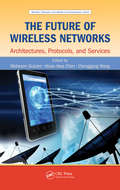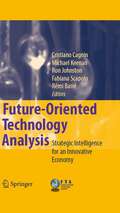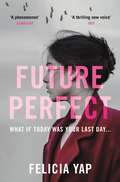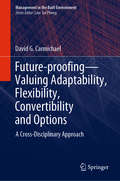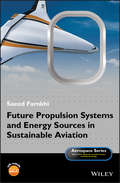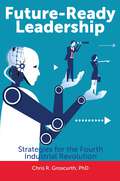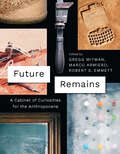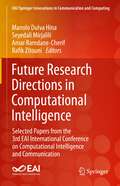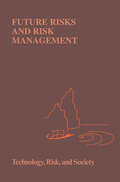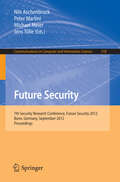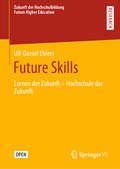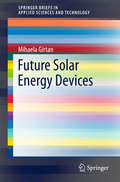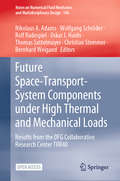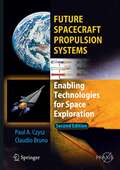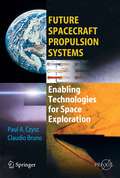- Table View
- List View
The Future of Wireless Networks: Architectures, Protocols, and Services (Wireless Networks And Mobile Communications Ser.)
by Mohesen Guizani Hsiao-Hwa Chen Chonggang WangThe exponential increase in mobile device users and high-bandwidth applications has pushed the current 3G and 4G wireless networks to their capacity. Moreover, it is predicted that mobile data traffic will continue to grow by over 300 percent by 2017. To handle this spectacular growth, the development of improved wireless networks for the future ha
Future Optical Access Network: Design and Modelling of FTTX/5G/IoT/Smart City Applications and Services (Springer Tracts in Electrical and Electronics Engineering)
by Santosh Kumar Carlos Marques Abhilasha Mishra Rajendraprasad A. PagareThis book provides detailed information on a low-cost, high-speed infrastructure to support applications and services based on 5G/6G, the Internet of Things (IoT), smart cities, and fiber-to-the-x (FTTX). The contents will serve as a ready reference for researchers, design engineers, network operators, and service providers, as well as graduating engineers interested in pursuing careers in the optical access network domain. The book is a road map for designing and developing access networks for a variety of applications, including smart cities and long-distance high-speed access networks. The book is useful for undergraduate, postgraduate, and research students, particularly in developing South-East Asian countries.
Future-Oriented Technology Analysis: Strategic Intelligence for an Innovative Economy
by Cristiano Cagnin Michael Keenan Ron Johnston Fabiana Scapolo Rémi BarréThe application of foresight to address the challenges of uncertainty and rapid change has grown dramatically in the past decade. In that period, the techniques have been greatly refined and the scope has been broadened to encompass future-oriented technology analysis (FTA) and more recently, the concept and practice of strategic intelligence. FTA addresses directly the longer-term future through the active and continuous development of visions, and pathways to realise these visions. It is increasingly seen as a valuable management and policy tool complementing, and extending further into the future, classical strategy, planning, and decision-making approaches. This book charts the development of FTA and provides the first coherent description and analysis of its practical application and impact in the worlds of business, government, education and research in both advanced and developing countries. It draws on papers addressing the application of FTA around the globe which were presented at the Second International Seville Seminar in September 2006. The insights and practical experience will be invaluable for company managers, government ministers and officials, researchers and academics with responsibilities for effective planning and decision-making in an increasingly turbulent and unpredictable world.
Future-Oriented Technology Assessment: A Manager's Guide with Case Applications (IEEE Press Series on Technology Management, Innovation, and Leadership)
by Tugrul U. Daim Haydar YalcinComprehensive resource explaining how to evaluate technologies for different purposes in any industry using four different practical approaches Future-Oriented Technology Assessment offers a comprehensive view of technology assessment structured into three different practical approaches: Technology Evaluation, Technology Roadmapping, and Technology Intelligence. The first four chapters include studies which utilize technology gap analysis, multiple criteria decision analysis, expert assessment quantification or neural networks to evaluate or forecast technology alternatives. The next five chapters apply bibliometric analysis, patent analysis, and network analysis to identify technology trends and the leaders in the field. The final four chapters use technology roadmapping, which charts a comprehensive plan for implementing technology. Additional topics covered in Future-Oriented Technology Assessment include: Smart grid technology as an alternative to fossil fuel consumptionHeat pump water heaters that reduce the cost of energy and improve energy efficiency, with particular focus on research from the US and ChinaNanotechnology in construction in Saudi Arabia to improve heat insulation, energy efficiency, and tensile strength in green building designs With comprehensive, practical insight into evaluating emerging technologies across different industries, Future-Oriented Technology Assessment is an essential read for researchers in technology and professionals in engineering and technology management, along with professionals and graduate students in related disciplines and programs of study.
Future-Oriented Technology Assessment: A Manager's Guide with Case Applications (IEEE Press Series on Technology Management, Innovation, and Leadership)
by Tugrul U. Daim Haydar YalçınComprehensive resource explaining how to evaluate technologies for different purposes in any industry using four different practical approaches Future-Oriented Technology Assessment offers a comprehensive view of technology assessment structured into three different practical approaches: Technology Evaluation, Technology Roadmapping, and Technology Intelligence. The first four chapters include studies which utilize technology gap analysis, multiple criteria decision analysis, expert assessment quantification or neural networks to evaluate or forecast technology alternatives. The next five chapters apply bibliometric analysis, patent analysis, and network analysis to identify technology trends and the leaders in the field. The final four chapters use technology roadmapping, which charts a comprehensive plan for implementing technology. Additional topics covered in Future-Oriented Technology Assessment include: Smart grid technology as an alternative to fossil fuel consumptionHeat pump water heaters that reduce the cost of energy and improve energy efficiency, with particular focus on research from the US and ChinaNanotechnology in construction in Saudi Arabia to improve heat insulation, energy efficiency, and tensile strength in green building designs With comprehensive, practical insight into evaluating emerging technologies across different industries, Future-Oriented Technology Assessment is an essential read for researchers in technology and professionals in engineering and technology management, along with professionals and graduate students in related disciplines and programs of study.
Future Perfect
by Felicia YapWhat if today was your last day... A bomb has exploded during a fashion show, killing a beautiful model on the catwalk. The murderer is still at large... and he may strike again. Yet this is the least of Police Commissioner Christian Verger's worries. His fiancée Viola has left him. He has to keep his tumultuous past a secret. To make things worse, his voice assistant Alexa is 99.74% sure he will die tomorrow.Moving from snowy 1980s Montana to chic 1990s Manhattan to a drone-filled 2030s Britain, FUTURE PERFECT is an electrifying race to solve a murder before it's too late. Yet it is also a love story, a riveting portrait of a couple torn apart by secrets, grief and guilt. A twisted tale of how the past can haunt a person's future and be used to predict if he will die... or kill.'Yap is a phenomenon' - Guardian'A thrilling new voice' - Red'The one that everyone is talking about . . . Enthralling' - Woman & Home'A blockbuster-worthy twist . . . YESTERDAY stands out from the crowd' - Stylist'The intrigue of GONE GIRL and the drama of BEFORE I GO TO SLEEP - iNews
Future-proofing—Valuing Adaptability, Flexibility, Convertibility and Options: A Cross-Disciplinary Approach (Management in the Built Environment)
by David G. CarmichaelThis book presents a unifying approach to the valuation of incorporated flexibility. Flexibility, in general terms, recognizes future uncertainty and refers to being proactive now so as to secure the future possibility of being able to adapt, convert, or generally introduce a change, if it is worthwhile to do so at the time. That is, deliberate provision is made now in order to have the ability (but not the obligation) to adapt, convert, or change in the future; this change is discretionary, and depends on future circumstances. The applications demonstrated here cover engineering, building, housing, finance, economics, contracts, general management, and project management. The examples are as follows: designing/building features in infrastructure (including buildings and houses) such that the infrastructure can be adapted in response to future changes in climate, demographics, or usage; incorporating features in contracts such that the terms and conditions can be changed in response to changing situations; purchasing rights now such that options exist to buy or sell an asset in the future; structuring a financial investment agreement so that its terms and conditions can be changed in the future; structuring project payments to provide future guarantees of revenue if needed; and designing an operation such that it can be expanded, contracted, abandoned, switched, changed, delayed, or deferred in the future. The level of required mathematics is kept at a very modest level: an undergraduate knowledge of algebra and probability is all that is required. Numerical examples, accompanied by readily understandable diagrams, illustrate the methods outlined. The formulations are kept straightforward and accessible for practitioners and academics alike.
Future Propulsion Systems and Energy Sources in Sustainable Aviation (Aerospace Series)
by Saeed FarokhiA comprehensive review of the science and engineering behind future propulsion systems and energy sources in sustainable aviation Future Propulsion Systems and Energy Sources: in sustainable aviation is a comprehensive reference that offers a review of the science and engineering principles that underpin the concepts of propulsion systems and energy sources in sustainable air transportation. The author – a noted expert in the field – examines the impact of air transportation on the environment and reviews alternative jet fuels, hybrid-electric and nuclear propulsion and power. He also explores modern propulsion for transonic and supersonic-hypersonic aircraft and the impact of propulsion on aircraft design. Climate change is the main driver for the new technology development in sustainable air transportation. The book contains critical review of gas turbine propulsion and aircraft aerodynamics; followed by an insightful presentation of the aviation impact on environment. Future fuels and energy sources are introduced in a separate chapter. Promising technologies in propulsion and energy sources are identified leading to pathways to sustainable aviation. To facilitate the utility of the subject, the book is accompanied by a website that contains illustrations, and equation files. This important book: Contains a comprehensive reference to the science and engineering behind propulsion and power in sustainable air transportation Examines the impact of air transportation on the environment Covers alternative jet fuels and hybrid-electric propulsion and power Discusses modern propulsion for transonic, supersonic and hypersonic aircraft Examines the impact of propulsion system integration on aircraft design Written for engineers, graduate and senior undergraduate students in mechanical and aerospace engineering, Future Propulsion Systems and Energy Sources: in sustainable aviation explores the future of aviation with a guide to sustainable air transportation that includes alternative jet fuels, hybrid-electric propulsion, all-electric and nuclear propulsion.
Future Propulsion Systems and Energy Sources in Sustainable Aviation (Aerospace Series)
by Saeed FarokhiA comprehensive review of the science and engineering behind future propulsion systems and energy sources in sustainable aviation Future Propulsion Systems and Energy Sources: in sustainable aviation is a comprehensive reference that offers a review of the science and engineering principles that underpin the concepts of propulsion systems and energy sources in sustainable air transportation. The author – a noted expert in the field – examines the impact of air transportation on the environment and reviews alternative jet fuels, hybrid-electric and nuclear propulsion and power. He also explores modern propulsion for transonic and supersonic-hypersonic aircraft and the impact of propulsion on aircraft design. Climate change is the main driver for the new technology development in sustainable air transportation. The book contains critical review of gas turbine propulsion and aircraft aerodynamics; followed by an insightful presentation of the aviation impact on environment. Future fuels and energy sources are introduced in a separate chapter. Promising technologies in propulsion and energy sources are identified leading to pathways to sustainable aviation. To facilitate the utility of the subject, the book is accompanied by a website that contains illustrations, and equation files. This important book: Contains a comprehensive reference to the science and engineering behind propulsion and power in sustainable air transportation Examines the impact of air transportation on the environment Covers alternative jet fuels and hybrid-electric propulsion and power Discusses modern propulsion for transonic, supersonic and hypersonic aircraft Examines the impact of propulsion system integration on aircraft design Written for engineers, graduate and senior undergraduate students in mechanical and aerospace engineering, Future Propulsion Systems and Energy Sources: in sustainable aviation explores the future of aviation with a guide to sustainable air transportation that includes alternative jet fuels, hybrid-electric propulsion, all-electric and nuclear propulsion.
Future-Ready Leadership: Strategies for the Fourth Industrial Revolution
by Chris R. GroscurthProvides executive leadership teams with information, tools, and advice they need to lead their organizations into the "future of work," characterized by transformative, smart, and connected technologies already under way, including artificial intelligence, the Internet of things, and automation.The technological and economic forces of the fourth industrial revolution (4IR) are shifting organizations in radical new directions. Automation is taking place not only in factories but in retail environments, and it is not just powerful or precise: it is intelligent, and it learns. Leaders must learn to rely on new sources of data, analytics, and intelligence in their efforts to anticipate emerging trends, forecast unforeseen consequences, make sense of systems and complexity, communicate constantly, build strong networks based on trust, and ultimately, win a following.Future-Ready Leadership is an invaluable resource for leaders and leadership educators seeking to transform 4IR trends into a source of collaborative (as opposed to competitive) advantage. A blueprint for reshaping the future of work, the book meets readers' "awareness need" by exploring cutting-edge research on technology's impact on the workplace. Each chapter uses data to set up a specific future of work leadership challenge, offering readers practical solutions and advice, actionable recommendations, and tools for reflection and action that can be put into practice right away.
Future-Ready Leadership: Strategies for the Fourth Industrial Revolution
by Chris R. GroscurthProvides executive leadership teams with information, tools, and advice they need to lead their organizations into the "future of work," characterized by transformative, smart, and connected technologies already under way, including artificial intelligence, the Internet of things, and automation.The technological and economic forces of the fourth industrial revolution (4IR) are shifting organizations in radical new directions. Automation is taking place not only in factories but in retail environments, and it is not just powerful or precise: it is intelligent, and it learns. Leaders must learn to rely on new sources of data, analytics, and intelligence in their efforts to anticipate emerging trends, forecast unforeseen consequences, make sense of systems and complexity, communicate constantly, build strong networks based on trust, and ultimately, win a following.Future-Ready Leadership is an invaluable resource for leaders and leadership educators seeking to transform 4IR trends into a source of collaborative (as opposed to competitive) advantage. A blueprint for reshaping the future of work, the book meets readers' "awareness need" by exploring cutting-edge research on technology's impact on the workplace. Each chapter uses data to set up a specific future of work leadership challenge, offering readers practical solutions and advice, actionable recommendations, and tools for reflection and action that can be put into practice right away.
Future Remains: A Cabinet of Curiosities for the Anthropocene
by Gregg Mitman Marco Armiero Robert EmmettWhat can a pesticide pump, a jar full of sand, or an old calico print tell us about the Anthropocene—the age of humans? Just as paleontologists look to fossil remains to infer past conditions of life on earth, so might past and present-day objects offer clues to intertwined human and natural histories that shape our planetary futures. In this era of aggressive hydrocarbon extraction, extreme weather, and severe economic disparity, how might certain objects make visible the uneven interplay of economic, material, and social forces that shape relationships among human and nonhuman beings? Future Remains is a thoughtful and creative meditation on these questions. The fifteen objects gathered in this book resemble more the tarots of a fortuneteller than the archaeological finds of an expedition—they speak of planetary futures. Marco Armiero, Robert S. Emmett, and Gregg Mitman have assembled a cabinet of curiosities for the Anthropocene, bringing together a mix of lively essays, creatively chosen objects, and stunning photographs by acclaimed photographer Tim Flach. The result is a book that interrogates the origins, implications, and potential dangers of the Anthropocene and makes us wonder anew about what exactly human history is made of.
Future Remains: A Cabinet of Curiosities for the Anthropocene
by Gregg Mitman Marco Armiero Robert EmmettWhat can a pesticide pump, a jar full of sand, or an old calico print tell us about the Anthropocene—the age of humans? Just as paleontologists look to fossil remains to infer past conditions of life on earth, so might past and present-day objects offer clues to intertwined human and natural histories that shape our planetary futures. In this era of aggressive hydrocarbon extraction, extreme weather, and severe economic disparity, how might certain objects make visible the uneven interplay of economic, material, and social forces that shape relationships among human and nonhuman beings? Future Remains is a thoughtful and creative meditation on these questions. The fifteen objects gathered in this book resemble more the tarots of a fortuneteller than the archaeological finds of an expedition—they speak of planetary futures. Marco Armiero, Robert S. Emmett, and Gregg Mitman have assembled a cabinet of curiosities for the Anthropocene, bringing together a mix of lively essays, creatively chosen objects, and stunning photographs by acclaimed photographer Tim Flach. The result is a book that interrogates the origins, implications, and potential dangers of the Anthropocene and makes us wonder anew about what exactly human history is made of.
Future Remains: A Cabinet of Curiosities for the Anthropocene
by Gregg Mitman Marco Armiero Robert S. EmmettWhat can a pesticide pump, a jar full of sand, or an old calico print tell us about the Anthropocene—the age of humans? Just as paleontologists look to fossil remains to infer past conditions of life on earth, so might past and present-day objects offer clues to intertwined human and natural histories that shape our planetary futures. In this era of aggressive hydrocarbon extraction, extreme weather, and severe economic disparity, how might certain objects make visible the uneven interplay of economic, material, and social forces that shape relationships among human and nonhuman beings? Future Remains is a thoughtful and creative meditation on these questions. The fifteen objects gathered in this book resemble more the tarots of a fortuneteller than the archaeological finds of an expedition—they speak of planetary futures. Marco Armiero, Robert S. Emmett, and Gregg Mitman have assembled a cabinet of curiosities for the Anthropocene, bringing together a mix of lively essays, creatively chosen objects, and stunning photographs by acclaimed photographer Tim Flach. The result is a book that interrogates the origins, implications, and potential dangers of the Anthropocene and makes us wonder anew about what exactly human history is made of.
Future Remains: A Cabinet of Curiosities for the Anthropocene
by Gregg Mitman Marco Armiero Robert S. EmmettWhat can a pesticide pump, a jar full of sand, or an old calico print tell us about the Anthropocene—the age of humans? Just as paleontologists look to fossil remains to infer past conditions of life on earth, so might past and present-day objects offer clues to intertwined human and natural histories that shape our planetary futures. In this era of aggressive hydrocarbon extraction, extreme weather, and severe economic disparity, how might certain objects make visible the uneven interplay of economic, material, and social forces that shape relationships among human and nonhuman beings? Future Remains is a thoughtful and creative meditation on these questions. The fifteen objects gathered in this book resemble more the tarots of a fortuneteller than the archaeological finds of an expedition—they speak of planetary futures. Marco Armiero, Robert S. Emmett, and Gregg Mitman have assembled a cabinet of curiosities for the Anthropocene, bringing together a mix of lively essays, creatively chosen objects, and stunning photographs by acclaimed photographer Tim Flach. The result is a book that interrogates the origins, implications, and potential dangers of the Anthropocene and makes us wonder anew about what exactly human history is made of.
Future Remains: A Cabinet of Curiosities for the Anthropocene
by Gregg Mitman Marco Armiero Robert S. EmmettWhat can a pesticide pump, a jar full of sand, or an old calico print tell us about the Anthropocene—the age of humans? Just as paleontologists look to fossil remains to infer past conditions of life on earth, so might past and present-day objects offer clues to intertwined human and natural histories that shape our planetary futures. In this era of aggressive hydrocarbon extraction, extreme weather, and severe economic disparity, how might certain objects make visible the uneven interplay of economic, material, and social forces that shape relationships among human and nonhuman beings? Future Remains is a thoughtful and creative meditation on these questions. The fifteen objects gathered in this book resemble more the tarots of a fortuneteller than the archaeological finds of an expedition—they speak of planetary futures. Marco Armiero, Robert S. Emmett, and Gregg Mitman have assembled a cabinet of curiosities for the Anthropocene, bringing together a mix of lively essays, creatively chosen objects, and stunning photographs by acclaimed photographer Tim Flach. The result is a book that interrogates the origins, implications, and potential dangers of the Anthropocene and makes us wonder anew about what exactly human history is made of.
Future Remains: A Cabinet of Curiosities for the Anthropocene
What can a pesticide pump, a jar full of sand, or an old calico print tell us about the Anthropocene—the age of humans? Just as paleontologists look to fossil remains to infer past conditions of life on earth, so might past and present-day objects offer clues to intertwined human and natural histories that shape our planetary futures. In this era of aggressive hydrocarbon extraction, extreme weather, and severe economic disparity, how might certain objects make visible the uneven interplay of economic, material, and social forces that shape relationships among human and nonhuman beings? Future Remains is a thoughtful and creative meditation on these questions. The fifteen objects gathered in this book resemble more the tarots of a fortuneteller than the archaeological finds of an expedition—they speak of planetary futures. Marco Armiero, Robert S. Emmett, and Gregg Mitman have assembled a cabinet of curiosities for the Anthropocene, bringing together a mix of lively essays, creatively chosen objects, and stunning photographs by acclaimed photographer Tim Flach. The result is a book that interrogates the origins, implications, and potential dangers of the Anthropocene and makes us wonder anew about what exactly human history is made of.
Future Research Directions in Computational Intelligence: Selected Papers from the 3rd EAI International Conference on Computational Intelligence and Communication (EAI/Springer Innovations in Communication and Computing)
by Manolo Dulva Hina Seyedali Mirjalili Amar Ramdane-Cherif Rafik ZitouniThis book presents select papers from 3rd EAI International Conference on Computational Intelligence and Communications (CICom 2022). The papers reveal recent advances in the broader domains of Computational Intelligence including (1) automation, control, and intelligent transportation system, (2) big data, internet of things, and smart cities, (3) wireless communication systems and cyber security and (4) human/brain-computer interfaces, and image and pattern recognition. The book demonstrates complex real-world problems in which mathematical or traditional modellings are not the preferred solution, hence alternative solutions are needed. This collection of applications demonstrates the important advances in computational intelligence. The book chapters’ present various ideas that will benefit researchers, graduate students and engineers in this domain.
Future Risks and Risk Management (Risk, Governance and Society #9)
by Nils-EricSahlin BerndtBrehmerFuture Risks and Risk Management provides a broad perspective on risk, including basic philosophical issues concerned with values, psychological issues, such as the perception of risk, the factors that generate risks in current and future technological and social systems, including both technical and organizational factors. No other volume adopts this broad perspective. Future Risks and Risk Management will be useful in a variety of contexts, both for teaching and as a source book for the risk professional needing to be informed of the broader issues in the field.
Future Security: 7th Security Research Conference, Future Security 2012, Bonn, Germany, September 4-6, 2012. Proceedings (Communications in Computer and Information Science #318)
by Nils Aschenbruck Peter Martini Michael Meier Jens TölleThis book constitutes the refereed proceedings of the 7th Security Research Conference, Future Security 2012, held in Bonn, Germany, in September 2012. The 78 revised full papers presented were carefully reviewed and selected from 137 submissions. The papers are organized in topical sections on supply chain and critical infrastructure protection; security situational awareness; crisis management; security for critical infrastructure and urban areas; sensor technology; social, psychological and political aspects; cyber defense and information security; maritime and border security; detection of hazardous materials; food chain security; aviation security; ergonomic aspects.
Future Skills: Lernen der Zukunft - Hochschule der Zukunft (Zukunft der Hochschulbildung - Future Higher Education)
by Ulf-Daniel EhlersDieses Open Access-Buch analysiert veränderte Grundkoordinaten der Hochschulbildung weltweit und stellt die Frage, wie Hochschulbildung sich entwickeln muss, um in einer Welt globaler Herausforderungen, sich immer schneller wandelnden gesellschaftlichen Umbrüchen und innovationsgetriebenen, agilen Arbeitsfeldern bestehen können. Mit der NextSkills-Studie wird über ein qualitativ-quantitatives Multimethodendesign erstmals ein ganzheitliches bildungswissenschaftlich fundiertes Future Skills Konzept konstruiert und validiert. Future Skills und das ihnen zugrunde liegende Triple Helix Model zukünftiger Handlungsfähigkeit werden im Detail beschrieben. Das Buch führt die Diskussionsstränge um die Zukunft der Hochschule zusammen. Es beschreibt die 10 Sekunden zukünftiger Hochschulentwicklung und entwickelt vier Szenarien für die Hochschule der Zukunft.
Future Solar Energy Devices (SpringerBriefs in Applied Sciences and Technology)
by Mihaela GirtanThis book addresses electronics and the rise of photonics, and asks what the future holds in store for this technology. It highlights the latest research on all types of solar cells and photonic devices, and a new approach combining photonics and electronics. Beyond simply explaining the existing systems or providing a synthesis of the current state of knowledge, the book also offers readers new perspectives for their own research. Lastly, drawing on the interconnections between electronics and photonics, the book suggests a possible means of using solar energy directly with the aid of future photonic devices.
Future Space-Transport-System Components under High Thermal and Mechanical Loads: Results from the DFG Collaborative Research Center TRR40 (Notes on Numerical Fluid Mechanics and Multidisciplinary Design #146)
by Nikolaus A. Adams Wolfgang Schröder Rolf Radespiel Oskar J. Haidn Thomas Sattelmayer Christian Stemmer Bernhard WeigandThis open access book presents the findings of Collaborative Research Center Transregio 40 (TRR40), initiated in July 2008 and funded by the German Research Foundation (DFG). Gathering innovative design concepts for thrust chambers and nozzles, as well as cutting-edge methods of aft-body flow control and propulsion-component cooling, it brings together fundamental research undertaken at universities, testing carried out at the German Aerospace Center (DLR) and industrial developments from the ArianeGroup. With a particular focus on heat transfer analyses and novel cooling concepts for thermally highly loaded structures, the book highlights the aft-body flow of the space transportation system and its interaction with the nozzle flow, which are especially critical during the early phase of atmospheric ascent. Moreover, it describes virtual demonstrators for combustion chambers and nozzles, and discusses their industrial applicability. As such, it is a timely resource for researchers, graduate students and practitioners.
Future Spacecraft Propulsion Systems: Enabling Technologies for Space Exploration (Springer Praxis Books)
by Claudio Bruno Paul A. CzyszAn understandable perspective on the types of space propulsion systems necessary to enable low-cost space flights to Earth orbit and to the Moon and the future developments necessary for exploration of the solar system and beyond to the stars.
Future Spacecraft Propulsion Systems: Enabling Technologies for Space Exploration (Springer Praxis Bks.)
by Paul A. Czysz Claudio BrunoAn understandable perspective on the types of space propulsion systems necessary to enable low-cost space flights to Earth orbit and to the Moon and the future developments necessary for exploration of the solar system and beyond to the stars.
